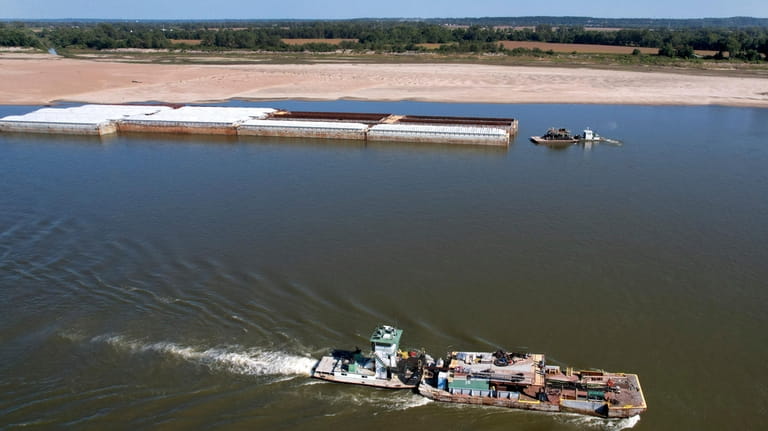Mississippi
Low Mississippi River limits barges just as farmers want to move their crops downriver

DES MOINES, Iowa — A long stretch of hot, dry weather has left the Mississippi River so low that barge companies are reducing their loads just as Midwest farmers are preparing to harvest crops and send tons of corn and soybeans downriver to the Gulf of Mexico.
The transport restrictions are a headache for barge companies, but even more worrisome for thousands of farmers who have watched drought scorch their fields for much of the summer. Now they will face higher prices to transport what remains of their crops.
Farmer Bruce Peterson, who grows corn and soybeans in southeastern Minnesota, chuckled wryly that the dry weather had withered his family’s crop so extensively they won’t need to worry so much about the high cost of transporting the goods downriver.
“We haven’t had rain here for several weeks so our crop size is shrinking,” Peterson said. “Unfortunately, that has taken care of part of the issue.”
About 60% of U.S. grain exports are taken by barge down the Mississippi to New Orleans, where the corn, soybeans and wheat is stored and ultimately transferred to other ships. It’s usually an inexpensive, efficient way to transport crops, as a typical group of 15 barges lashed together carries as much cargo as about 1,000 trucks.
But as river levels drop, that cost has soared. The cargo rate from St. Louis southward is now up 77% above the three-year average.
Prices have risen because the river south of St. Louis does not remain consistently deep enough now to accommodate typical barges, forcing companies to load less into each vessel and string fewer barges together.
A tugboat powers past barges on one side and exposed riverbed on the other along the Mississippi River Friday, Sept. 15, 2023, in St. Louis. A long stretch of hot, dry weather has left the Mississippi River so low that barge companies are reducing their loads just as Midwest farmers are preparing to harvest their crops and send tons of corn and soybeans downriver to the Gulf of Mexico. Credit: AP/Jeff Roberson
North of St. Louis, a series of locks and dams guarantees a 9-foot-deep (2.7-meter) channel as far north as Minneapolis-St. Paul. But that’s not the case in the lower Mississippi.
“We’re keeping things moving but could use some rain, some help from Mother Nature,” said Merritt Lane, president of Canal Barge Company of New Orleans.
Canal Barge, which works much of the Mississippi as well as the Illinois and Ohio rivers, has had to lighten loads so barges ride higher in the water. The company also can’t link as many barges together because the shipping lane is narrower, Lane said.
A narrowed shipping lane also means barges from different companies must squeeze into limited space, forcing backups and delays.
Tugboats work in low water levels along the Mississippi River, Friday, Sept. 15, 2023, in St. Louis. A long stretch of hot, dry weather has left the Mississippi River so low that barge companies are reducing their loads just as Midwest farmers are preparing to harvest their crops and send tons of corn and soybeans downriver to the Gulf of Mexico. Credit: AP/Jeff Roberson

This is the second-straight year drought has caused the Mississippi to drop to near-record lows. With no significant rain in the forecast, it’s likely to keep falling.
The shallow river is especially striking given the height of the river just months ago. A huge snowpack in northern Minnesota and Wisconsin quickly melted, forcing riverfront communities such as Davenport, Iowa, and Savanna, Illinois, to hurriedly erect barriers to stay dry in late April and early May.
Though floodwaters quickly receded, they left behind mountains of underwater sand, forcing the Corps of Engineers to “dredge like crazy” to clear out a shipping channel, said Tom Heinold, who commands the Corps’ Rock Island district spanning 312 miles (500 kilometers) of the Mississippi from northern Iowa south to Missouri.
“After the flood came through this spring it was a touchy situation,” Heinold said. “In May and June we were jumping very quickly from place to place to try to get pilot channels open as the water was dropping.”
Northern stretches of the river are now in good shape, but dredging continues south of St. Louis, Heinold said.
Months of dry and warm weather have hit the Midwest hard, damaging crops in much of the region west of the Mississippi River. In Kansas, 40% of the soybean crop was reported in poor or very poor condition, with the same conditions for 40% of the corn crop in Missouri.
The Midwest grows most of the nation’s corn and soybeans. The percentage rated good to excellent nationwide was a little more than 50%, the worst rating in more than a decade.
Then there is the higher cost of shipping crops downriver.
Mike Steenhoek, executive director of the Soy Transportation Coalition, said many Midwest farmers have multiple transport options, among them trucking and shipment by train for use by nearby ethanol and biodiesel plants and for processing into animal feed. But for grain exported from the U.S., the higher cost of shipping down the Mississippi hurts.
“It’s the way that farmers in the middle of the United States connect with the international marketplace,” said Steenhoek, whose group advocates for effective crop transportation systems. “It allows these farmers to have a very efficient way of moving their products a long distance in a very economical manner.”
Rising barge costs eating directly into farmers’ profits come at a time when American soybean and corn exports face increased international competition, he said.
From his work site beside the Mississippi River in Red Wing, Minnesota, Jim Larson watches as the river rises and falls through the seasons. He has seen plenty of droughts and floods during 30 years in the business and said it forces everyone who relies on the river to remain nimble.
“Some years you have flood and some years you have drought and sometimes you have them both in the same year,” said Larson, manager of Red Wing Grain, a storage and grain-loading operation. “It’s crazy and it seems like lately we’re having more of both, and so you have to be adaptable and change with the situation that is given to you. Kind of keeps you on your toes.”

Mississippi
Leading rusher Davon Booth announces return to Mississippi State football for 2025 season

Mississippi State football will leading rusher Davon Booth back next season season.
The running back and the Bulldogs revealed the news in a joint social media post on Tuesday that said, “Booth is back.”
Booth, who was a senior and out of eligibility, is allowed to return because of an NCAA decision in December to grant junior college players an extra year of eligibility for 2025-26. Booth played two seasons at Cerritos College in 2021 and 2022 before joining Utah State and transferring to MSU.
He rushed for 759 yards and five touchdowns this season and also caught four touchdowns. Booth also returned kickoffs, averaging 25.7 yards per return.
What Davon Booth’s return means for Mississippi State
The running back room looks like it will be one of the strengths for the Bulldogs with Booth’s return.
In addition to Booth, Mississippi State added South Alabama’s Fluff Bothwell in the transfer portal, who was an All-Sun Belt Third Team selection as a freshman this season. MSU is also expecting Seth Davis to be healthy after he missed the entire season with a knee injury. In 2023, Davis was second on the team in rushing and averaged 6.0 yards per carry. Xavier Gayten, a former four-star recruit, also flashed potential in a limited role this season as a freshman.
What’s most encouraging about Booth is how he finished the season. He didn’t arrive at Mississippi State until after the spring semester and didn’t run efficiently in the first half of the season. However, Booth had a five-game stretch in the second half of the season with at least 90 scrimmage yards in each game. That includes 100-yard rushing games against Tennessee and Missouri.
Sam Sklar is the Mississippi State beat reporter for the Clarion Ledger. Email him at ssklar@gannett.com and follow him on X @sklarsam_.
Mississippi
Where Mississippi State basketball stands in updated March Madness bracket predictions
Mississippi State basketball is projected for its highest NCAA tournament seed in 20 years.
The Bulldogs (13-1, 1-0 SEC) are off to a strong start to the season with only one loss − to Butler on a neutral court. They play at Vanderbilt (13-1, 1-0) on Tuesday (8 p.m., ESPNU).
Here is where MSU stands in the latest NCAA tournament projections.
Mississippi State basketball is as high as a No. 3 seed
CBS Sports’ Jerry Palm has Mississippi State as a No. 3 seed in the South Region. The Bulldogs would be matched up with No. 14 South Dakota State in Milwaukee. The winner would play either No. 6 seed Purdue or No. 11 seeds Vanderbilt or New Mexico, who are projected to play in the First Four.
ESPN’s Joe Lunardi lists MSU as a No. 4 seed in the West Region, matching up with No. 13 Grand Canyon. The second-round game would be against either No. 5 UCLA or No. 12 UC San Diego. Both rounds would be played in Denver.
Mississippi State basketball’s NCAA tournament resume
The Bulldogs are ranked No. 13 in the NCAA NET rankings as of Tuesday. They are 3-0 in Quad 1 games, beating Memphis, Pittsburgh and SMU. The loss to Butler is Quad 2, but MSU has wins in that quadrant against McNeese and Utah.
MSU’s 85-50 win against South Carolina on Saturday in the SEC opener is Quad 3.
Mississippi State is slated to play five straight Quad 1 games until it visits South Carolina on Jan. 25.
Mississippi State basketball’s NCAA tournament history under Chris Jans
The Bulldogs have made the NCAA tournament twice in coach Chris Jans’ two seasons but haven’t won a game.
In 2023, they were in the First Four and loss to Pitt by one point. Last season, No. 8 seed MSU lost by 18 to No. 9 Michigan State in the first round.
Mississippi State last won an NCAA tournament game in 2008, a first-round win against Oregon. It has not advanced past the round of 32 since 1996.
Sam Sklar is the Mississippi State beat reporter for the Clarion Ledger. Email him at ssklar@gannett.com and follow him on X @sklarsam_.
Mississippi
Mississippi Gulf Coast preps for cold; experts urge to protect four P’s

BILOXI, Miss. (WLOX) – With temperatures forecast to drop below freezing overnight, residents took action to combat the cold on Monday.
With the big chill setting in until midweek, both the Mississippi Emergency Management Agency and Mississippi Power posted reminders on social media about the importance of protecting the “Four P’s” – people, pets, plants, and pipes.
The following tips are recommended to keep everyone safe and warm:
- Check on family, friends, and neighbors, especially those with special needs and the elderly.
- Bring pets indoors. Remember, it’s a Mississippi law for pet owners to provide adequate shelter.
- Insulate or wrap exposed water pipes. Keep water dripping to avoid freezing.
- Cover any outdoor plants or bring them inside.
Pine Hills Nursery Manager Rachel Bond told WLOX that it’s not too late to bring plants inside.
“Yes, if you can bring the plant indoors, we do recommend that because you can control the environment and it is much warmer,” Bond said. “If it is something permanent that you can’t bring in, then we recommend covering it with a soft layer like a blanket or sheet and then plastic or tarp over that.”
“Then once temperatures are above freezing the next day you can go ahead and remove that,” she continued. “You don’t want to leave it covered for several days in a row. You want to uncover it and cover it again if you have to.”
The EMA also stressed the importance of preparing a “go-kit” for the vehicle, containing the following items:
- First Aid Kit
- Flashlight
- Battery Radio
- Jumper Cables
- Blanket
- Water & Non-perishable Food
- Playing Cards
- Extra Fuel
- Power Bank
- Ice Scraper
See a spelling or grammar error in this story? Report it to our team HERE.
Copyright 2025 WLOX. All rights reserved.
-

 Business7 days ago
Business7 days agoThese are the top 7 issues facing the struggling restaurant industry in 2025
-

 Culture7 days ago
Culture7 days agoThe 25 worst losses in college football history, including Baylor’s 2024 entry at Colorado
-

 Sports6 days ago
Sports6 days agoThe top out-of-contract players available as free transfers: Kimmich, De Bruyne, Van Dijk…
-

 Politics5 days ago
Politics5 days agoNew Orleans attacker had 'remote detonator' for explosives in French Quarter, Biden says
-

 Politics5 days ago
Politics5 days agoCarter's judicial picks reshaped the federal bench across the country
-

 Politics3 days ago
Politics3 days agoWho Are the Recipients of the Presidential Medal of Freedom?
-

 Health2 days ago
Health2 days agoOzempic ‘microdosing’ is the new weight-loss trend: Should you try it?
-

 World7 days ago
World7 days agoIvory Coast says French troops to leave country after decades



















